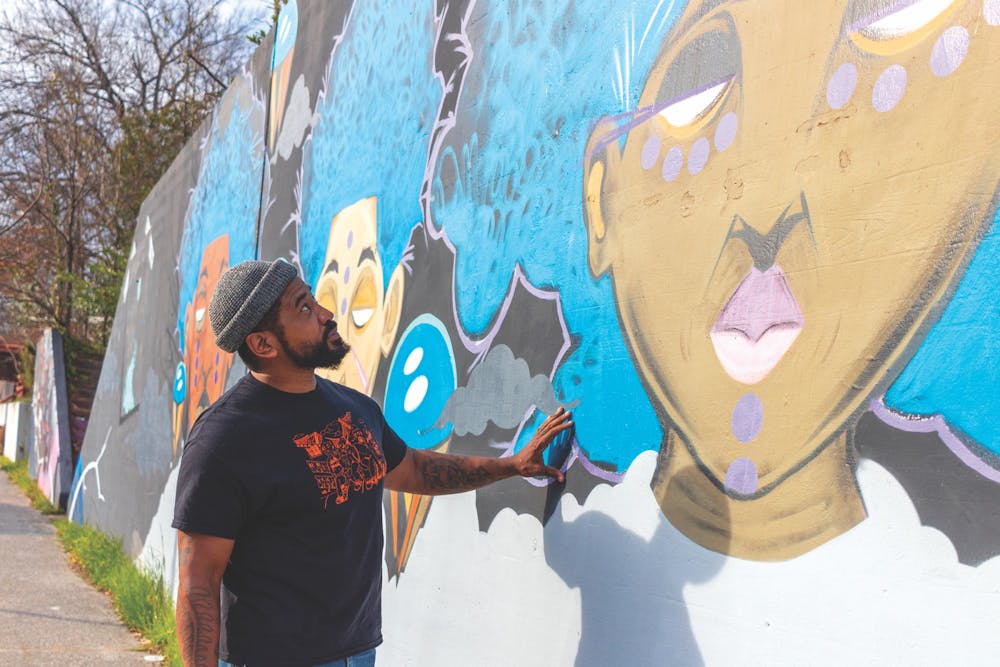Mural 2: Millwood Mural by Cedric Umoja (@umojaizm)
Sprawled out on various walls surrounding a staircase on Millwood Avenue, you’ll find Cedric Umoja’s Afrofuturist mural. Prior to City Year and One Columbia collaborating to commission Umoja and other artists to decorate the space, the wall was covered in an unfinished artwork for around eight to nine years. Umoja recollects that “years went by and nobody did any work there”. People were upset, even though City Year had the intention of completing the work, but they couldn’t get the first artist back. Seeing as the space borders the Waverly neighborhood, a self-contained, self-sustaining Black community, Umoja felt called to act on the unfinished space, saying “as a Black person and a Black artist and muralist, I felt it was my duty to do some art there”. Umoja made sure to get the blessings of the surrounding communities prior to starting the piece, and he was taken aback when “people were crying, they brought their kids, coming up to us every five minutes”, as they finally felt that their community could have a piece of public art to be proud of. He worked alongside fellow artists Brandon Donahue and Karl Zurfluh, who contributed to the sides of the mural while Umoja focused on the center.
The mural is sprawling and contains various elements on the walls surrounding the stairs. One will notice the stark, cool colors (specifically deep blues and blacks) that establish the three figures, the neon line work, and the community Post-It. These colors are contrasted by the bright, piercing reds that frame the piece: the pop-art beetle on the right, and the haunting owl on the left. Umoja says that the mural is his signature style of Afrofuturism, a style which “imagines Black people beyond the space we’ve been kept in,” combining dark-skinned figures with futuristic imagery. Umoja emphasizes that Afrofuturism is essential to “protect and uphold what happened in our past, be able to live or focus within this present, and project that into our future”. When he was younger he recalls being “bombarded with [the idea that] there isn’t a future with Black people in it’”, something movies and other media of his youth seemed to emphasize. “You’re seeing Black people in movies not making it to 21, getting murdered,” Umoja said. To him, Afrofuturism is “the idea of overcoming that and creating a future where we do exist and where we are impactful”. He also cites his grandmother’s TV shows as a source of inspiration, as he grew up on shows like Star Trek and Star Wars. “My grandmother didn’t have access to cable, so you had to watch what you could on TV. And, I became a Trekkie. And, I got into Star Wars. So, I’m a sci-fi kid,” he said, chuckling.
Umoja was always interested in self-expression, beginning with childhood drawing and painting before moving into his formal training. He went to an art school in Atlanta before taking up an apprenticeship with Tony Cacalano, who studied under teachers that influenced the modern masters like Rothko and Pollock. “I was blessed enough to study underneath him,” Umoja said. “I would pretty much be running everything I was doing through him.” Cacalano provided Umoja with extra work and exposure to the modern movement of art in America, which he transformed into a signature style by blending it with hip-hop culture and the street aspect of graffiti.
Umoja is hopeful for the future and is open to a world of opportunities. While he does enjoy public art, he doesn’t want to be pigeonholed as only a muralist. He is currently excited about his art being the cover for the Jasper Magazine and a review of his recent book, Spirit Truths Magic & Futures. He continues to work to have is work in art galleries, as he is committed to “make that space accessible to people who look like me”.
For Umoja, art is also about people, and its about advocacy and representation, a sentiment reflected through both his honest, wise words and through his passions. “Art has been made into an elitist thing, but it shouldn’t be. The best art comes from the struggle.”



